Manling Li
Re-thinking Temporal Search for Long-Form Video Understanding
Apr 03, 2025Abstract:Efficient understanding of long-form videos remains a significant challenge in computer vision. In this work, we revisit temporal search paradigms for long-form video understanding, studying a fundamental issue pertaining to all state-of-the-art (SOTA) long-context vision-language models (VLMs). In particular, our contributions are two-fold: First, we formulate temporal search as a Long Video Haystack problem, i.e., finding a minimal set of relevant frames (typically one to five) among tens of thousands of frames from real-world long videos given specific queries. To validate our formulation, we create LV-Haystack, the first benchmark containing 3,874 human-annotated instances with fine-grained evaluation metrics for assessing keyframe search quality and computational efficiency. Experimental results on LV-Haystack highlight a significant research gap in temporal search capabilities, with SOTA keyframe selection methods achieving only 2.1% temporal F1 score on the LVBench subset. Next, inspired by visual search in images, we re-think temporal searching and propose a lightweight keyframe searching framework, T*, which casts the expensive temporal search as a spatial search problem. T* leverages superior visual localization capabilities typically used in images and introduces an adaptive zooming-in mechanism that operates across both temporal and spatial dimensions. Our extensive experiments show that when integrated with existing methods, T* significantly improves SOTA long-form video understanding performance. Specifically, under an inference budget of 32 frames, T* improves GPT-4o's performance from 50.5% to 53.1% and LLaVA-OneVision-72B's performance from 56.5% to 62.4% on LongVideoBench XL subset. Our PyTorch code, benchmark dataset and models are included in the Supplementary material.
Why Is Spatial Reasoning Hard for VLMs? An Attention Mechanism Perspective on Focus Areas
Mar 04, 2025Abstract:Large Vision Language Models (VLMs) have long struggled with spatial reasoning tasks. Surprisingly, even simple spatial reasoning tasks, such as recognizing "under" or "behind" relationships between only two objects, pose significant challenges for current VLMs. In this work, we study the spatial reasoning challenge from the lens of mechanistic interpretability, diving into the model's internal states to examine the interactions between image and text tokens. By tracing attention distribution over the image through out intermediate layers, we observe that successful spatial reasoning correlates strongly with the model's ability to align its attention distribution with actual object locations, particularly differing between familiar and unfamiliar spatial relationships. Motivated by these findings, we propose ADAPTVIS based on inference-time confidence scores to sharpen the attention on highly relevant regions when confident, while smoothing and broadening the attention window to consider a wider context when confidence is lower. This training-free decoding method shows significant improvement (e.g., up to a 50 absolute point improvement) on spatial reasoning benchmarks such as WhatsUp and VSR with negligible cost. We make code and data publicly available for research purposes at https://github.com/shiqichen17/AdaptVis.
The Law of Knowledge Overshadowing: Towards Understanding, Predicting, and Preventing LLM Hallucination
Feb 22, 2025



Abstract:Hallucination is a persistent challenge in large language models (LLMs), where even with rigorous quality control, models often generate distorted facts. This paradox, in which error generation continues despite high-quality training data, calls for a deeper understanding of the underlying LLM mechanisms. To address it, we propose a novel concept: knowledge overshadowing, where model's dominant knowledge can obscure less prominent knowledge during text generation, causing the model to fabricate inaccurate details. Building on this idea, we introduce a novel framework to quantify factual hallucinations by modeling knowledge overshadowing. Central to our approach is the log-linear law, which predicts that the rate of factual hallucination increases linearly with the logarithmic scale of (1) Knowledge Popularity, (2) Knowledge Length, and (3) Model Size. The law provides a means to preemptively quantify hallucinations, offering foresight into their occurrence even before model training or inference. Built on overshadowing effect, we propose a new decoding strategy CoDa, to mitigate hallucinations, which notably enhance model factuality on Overshadow (27.9%), MemoTrap (13.1%) and NQ-Swap (18.3%). Our findings not only deepen understandings of the underlying mechanisms behind hallucinations but also provide actionable insights for developing more predictable and controllable language models.
EmbodiedBench: Comprehensive Benchmarking Multi-modal Large Language Models for Vision-Driven Embodied Agents
Feb 13, 2025



Abstract:Leveraging Multi-modal Large Language Models (MLLMs) to create embodied agents offers a promising avenue for tackling real-world tasks. While language-centric embodied agents have garnered substantial attention, MLLM-based embodied agents remain underexplored due to the lack of comprehensive evaluation frameworks. To bridge this gap, we introduce EmbodiedBench, an extensive benchmark designed to evaluate vision-driven embodied agents. EmbodiedBench features: (1) a diverse set of 1,128 testing tasks across four environments, ranging from high-level semantic tasks (e.g., household) to low-level tasks involving atomic actions (e.g., navigation and manipulation); and (2) six meticulously curated subsets evaluating essential agent capabilities like commonsense reasoning, complex instruction understanding, spatial awareness, visual perception, and long-term planning. Through extensive experiments, we evaluated 13 leading proprietary and open-source MLLMs within EmbodiedBench. Our findings reveal that: MLLMs excel at high-level tasks but struggle with low-level manipulation, with the best model, GPT-4o, scoring only 28.9% on average. EmbodiedBench provides a multifaceted standardized evaluation platform that not only highlights existing challenges but also offers valuable insights to advance MLLM-based embodied agents. Our code is available at https://embodiedbench.github.io.
SyncMind: Measuring Agent Out-of-Sync Recovery in Collaborative Software Engineering
Feb 10, 2025Abstract:Software engineering (SE) is increasingly collaborative, with developers working together on shared complex codebases. Effective collaboration in shared environments requires participants -- whether humans or AI agents -- to stay on the same page as their environment evolves. When a collaborator's understanding diverges from the current state -- what we term the out-of-sync challenge -- the collaborator's actions may fail, leading to integration issues. In this work, we introduce SyncMind, a framework that systematically defines the out-of-sync problem faced by large language model (LLM) agents in collaborative software engineering (CSE). Based on SyncMind, we create SyncBench, a benchmark featuring 24,332 instances of agent out-of-sync scenarios in real-world CSE derived from 21 popular GitHub repositories with executable verification tests. Experiments on SyncBench uncover critical insights into existing LLM agents' capabilities and limitations. Besides substantial performance gaps among agents (from Llama-3.1 agent <= 3.33% to Claude-3.5-Sonnet >= 28.18%), their consistently low collaboration willingness (<= 4.86%) suggests fundamental limitations of existing LLM in CSE. However, when collaboration occurs, it positively correlates with out-of-sync recovery success. Minimal performance differences in agents' resource-aware out-of-sync recoveries further reveal their significant lack of resource awareness and adaptability, shedding light on future resource-efficient collaborative systems. Code and data are openly available on our project website: https://xhguo7.github.io/SyncMind/.
LayoutVLM: Differentiable Optimization of 3D Layout via Vision-Language Models
Dec 03, 2024Abstract:Open-universe 3D layout generation arranges unlabeled 3D assets conditioned on language instruction. Large language models (LLMs) struggle with generating physically plausible 3D scenes and adherence to input instructions, particularly in cluttered scenes. We introduce LayoutVLM, a framework and scene layout representation that exploits the semantic knowledge of Vision-Language Models (VLMs) and supports differentiable optimization to ensure physical plausibility. LayoutVLM employs VLMs to generate two mutually reinforcing representations from visually marked images, and a self-consistent decoding process to improve VLMs spatial planning. Our experiments show that LayoutVLM addresses the limitations of existing LLM and constraint-based approaches, producing physically plausible 3D layouts better aligned with the semantic intent of input language instructions. We also demonstrate that fine-tuning VLMs with the proposed scene layout representation extracted from existing scene datasets can improve performance.
IKEA Manuals at Work: 4D Grounding of Assembly Instructions on Internet Videos
Nov 18, 2024Abstract:Shape assembly is a ubiquitous task in daily life, integral for constructing complex 3D structures like IKEA furniture. While significant progress has been made in developing autonomous agents for shape assembly, existing datasets have not yet tackled the 4D grounding of assembly instructions in videos, essential for a holistic understanding of assembly in 3D space over time. We introduce IKEA Video Manuals, a dataset that features 3D models of furniture parts, instructional manuals, assembly videos from the Internet, and most importantly, annotations of dense spatio-temporal alignments between these data modalities. To demonstrate the utility of IKEA Video Manuals, we present five applications essential for shape assembly: assembly plan generation, part-conditioned segmentation, part-conditioned pose estimation, video object segmentation, and furniture assembly based on instructional video manuals. For each application, we provide evaluation metrics and baseline methods. Through experiments on our annotated data, we highlight many challenges in grounding assembly instructions in videos to improve shape assembly, including handling occlusions, varying viewpoints, and extended assembly sequences.
HourVideo: 1-Hour Video-Language Understanding
Nov 07, 2024
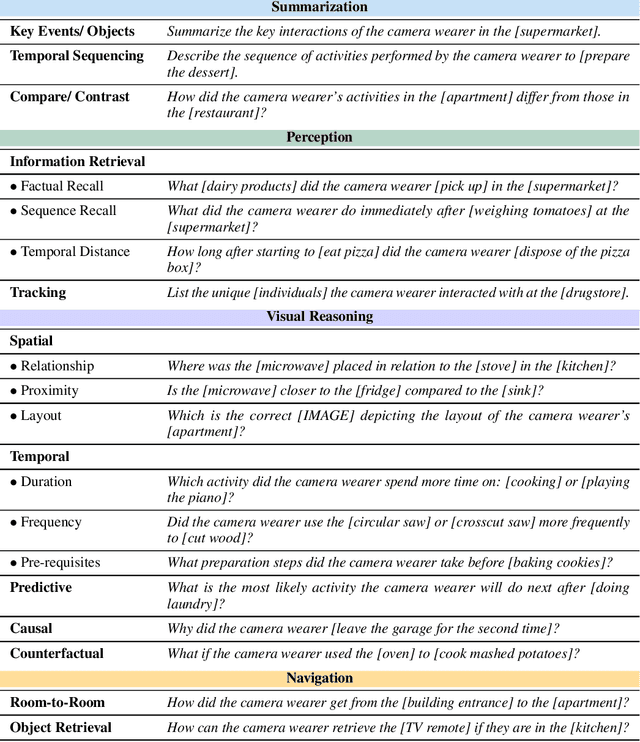

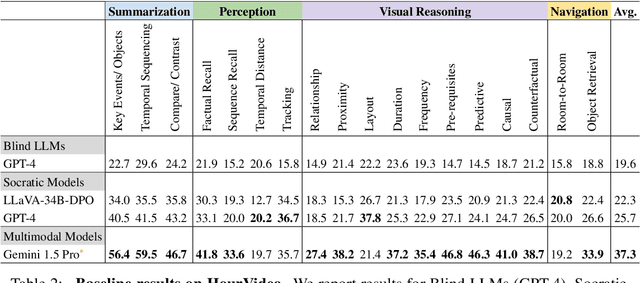
Abstract:We present HourVideo, a benchmark dataset for hour-long video-language understanding. Our dataset consists of a novel task suite comprising summarization, perception (recall, tracking), visual reasoning (spatial, temporal, predictive, causal, counterfactual), and navigation (room-to-room, object retrieval) tasks. HourVideo includes 500 manually curated egocentric videos from the Ego4D dataset, spanning durations of 20 to 120 minutes, and features 12,976 high-quality, five-way multiple-choice questions. Benchmarking results reveal that multimodal models, including GPT-4 and LLaVA-NeXT, achieve marginal improvements over random chance. In stark contrast, human experts significantly outperform the state-of-the-art long-context multimodal model, Gemini Pro 1.5 (85.0% vs. 37.3%), highlighting a substantial gap in multimodal capabilities. Our benchmark, evaluation toolkit, prompts, and documentation are available at https://hourvideo.stanford.edu
MentalArena: Self-play Training of Language Models for Diagnosis and Treatment of Mental Health Disorders
Oct 09, 2024



Abstract:Mental health disorders are one of the most serious diseases in the world. Most people with such a disease lack access to adequate care, which highlights the importance of training models for the diagnosis and treatment of mental health disorders. However, in the mental health domain, privacy concerns limit the accessibility of personalized treatment data, making it challenging to build powerful models. In this paper, we introduce MentalArena, a self-play framework to train language models by generating domain-specific personalized data, where we obtain a better model capable of making a personalized diagnosis and treatment (as a therapist) and providing information (as a patient). To accurately model human-like mental health patients, we devise Symptom Encoder, which simulates a real patient from both cognition and behavior perspectives. To address intent bias during patient-therapist interactions, we propose Symptom Decoder to compare diagnosed symptoms with encoded symptoms, and dynamically manage the dialogue between patient and therapist according to the identified deviations. We evaluated MentalArena against 6 benchmarks, including biomedicalQA and mental health tasks, compared to 6 advanced models. Our models, fine-tuned on both GPT-3.5 and Llama-3-8b, significantly outperform their counterparts, including GPT-4o. We hope that our work can inspire future research on personalized care. Code is available in https://github.com/Scarelette/MentalArena/tree/main
Embodied Agent Interface: Benchmarking LLMs for Embodied Decision Making
Oct 09, 2024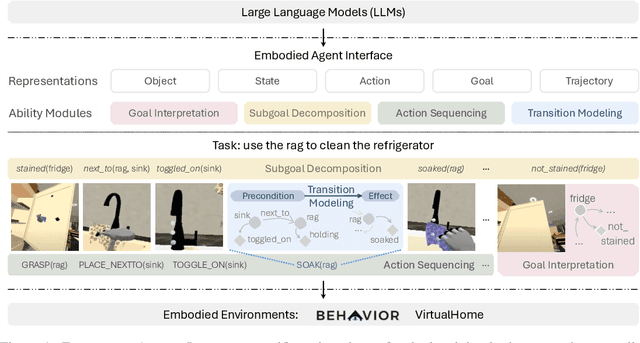
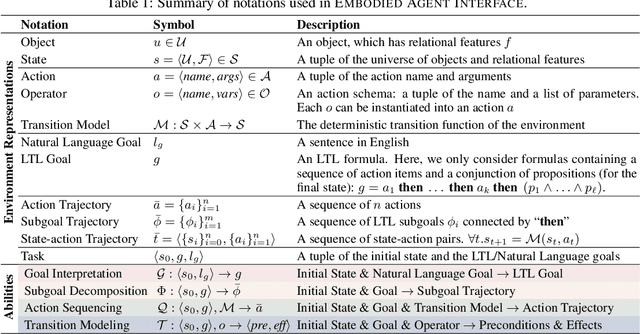
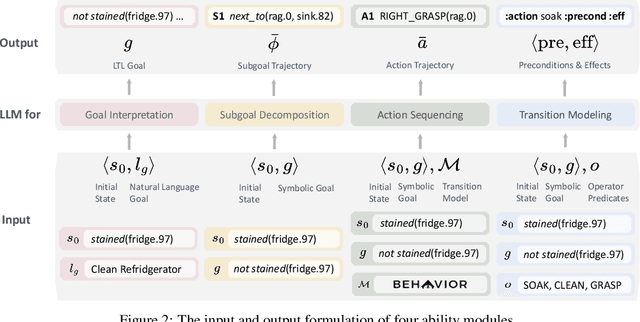
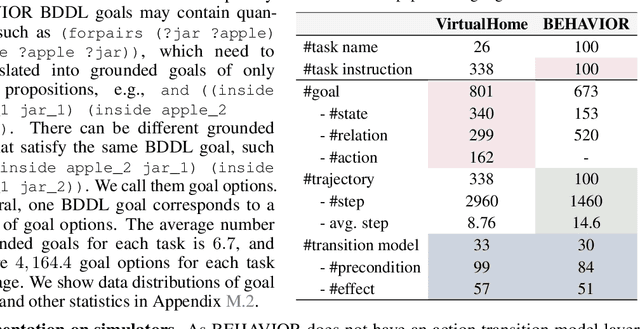
Abstract:We aim to evaluate Large Language Models (LLMs) for embodied decision making. While a significant body of work has been leveraging LLMs for decision making in embodied environments, we still lack a systematic understanding of their performance because they are usually applied in different domains, for different purposes, and built based on different inputs and outputs. Furthermore, existing evaluations tend to rely solely on a final success rate, making it difficult to pinpoint what ability is missing in LLMs and where the problem lies, which in turn blocks embodied agents from leveraging LLMs effectively and selectively. To address these limitations, we propose a generalized interface (Embodied Agent Interface) that supports the formalization of various types of tasks and input-output specifications of LLM-based modules. Specifically, it allows us to unify 1) a broad set of embodied decision-making tasks involving both state and temporally extended goals, 2) four commonly-used LLM-based modules for decision making: goal interpretation, subgoal decomposition, action sequencing, and transition modeling, and 3) a collection of fine-grained metrics which break down evaluation into various types of errors, such as hallucination errors, affordance errors, various types of planning errors, etc. Overall, our benchmark offers a comprehensive assessment of LLMs' performance for different subtasks, pinpointing the strengths and weaknesses in LLM-powered embodied AI systems, and providing insights for effective and selective use of LLMs in embodied decision making.
 Add to Chrome
Add to Chrome Add to Firefox
Add to Firefox Add to Edge
Add to Edge